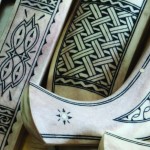
An exhibition named “Duodji – Sámi Handicrafts” was just opened in the Museum of Ethnography in Budapest. The exhibition will be available between August 8 and November 28, and is connected with the exhibition “How we see the Finns“, also available until November 28, 2010.
Duodji – Sámi Handicrafts
Museum of Ethnography
August 9 – November 28 (2010)
More about the exhibition (press release):
Ilmari Tapiola (b. 1955; Sámi name Gáva-Jon Ilmar) comes from a village of Kaava (Gávva) on the Teno River (Deatnu) in the municipality of Utsjoki. Tapiola is both a reindeer herder, an entrepreneur in the field of fishing tourism and a maker of handicraft.
When he was young, the prospects of Sámi handicraft were poor, especially as concerns the handicraft made by men. Industrial products had replaced the tools, dishes, containers and other objects in which things were kept that had been traditionally made at home, and there were only few masters of Sámi handicraft left.
Ilmari Tapiola learnt the basic skills of Sámi handicraft on the courses held at Christian Folk High School of Inari, where his teachers included Ilmari Laiti and Juhan Rist. In 1974, Tapiola left – with two other Sámi from Finland – for the Sámi High School of Jokkmokk, Sweden, to continue his training there for two years.
The handicraft exhibition of Ilmari Tapiola displays chests, dishes, bowls, boxes, knives, reeds, shuttles, horn spoons, belt buttons and hooks. Tapiola’s handicraft is characterized by distinct designs and strongly dyed stylized ornamentation that has been carved on the pieces of handicraft.
His themes include braids, plaits, basket-work ornamentation, stars and suns, but sometimes he decorates, freehand, his work with natural motifs and figures from the Sámi drums. He makes his handicraft both for the use of his own family and for sale.
The handicrafts of the exhibition are made of “hard” materials, that is, from birch gnarls and the high quality antlers of a bull reindeer. The gnarl lids of chests and containers and the handles of gnarl cups have been decorated with antler inlays. Some knife sheaths, reeds and shuttles are made from only one material: horn.
The carvings on the horn are made visible with the help of a colour that has been ground from charcoal. Air compressor tools have made it easier to work the materials, but it is now more difficult to actually get a hold of the materials that one needs.
The exhibition was conducted with the help of Finnagora and the Museum of Ethnography